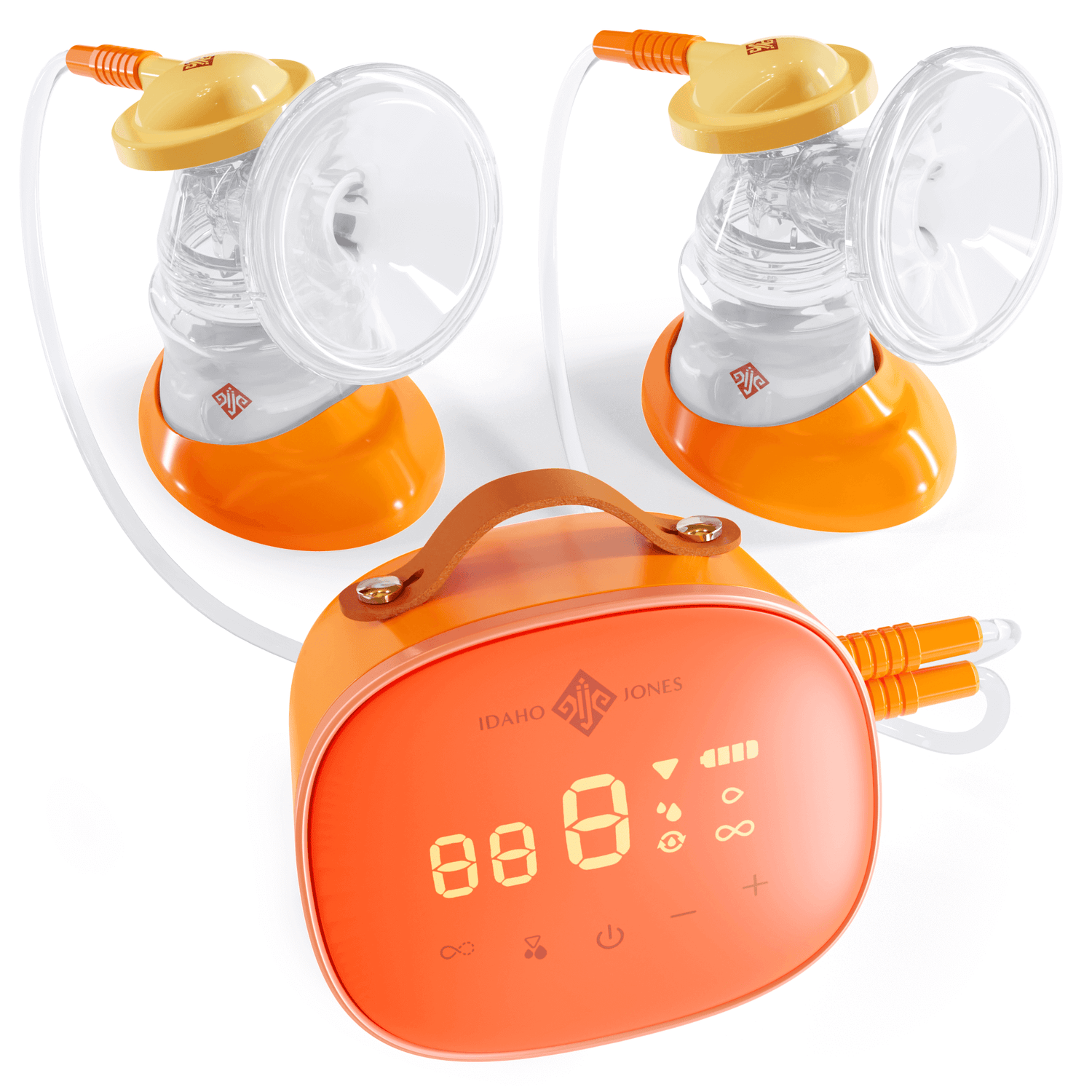
How Soon Does Milk Come In
Share
Your body will start making milk during pregnancy, beginning about halfway through the second trimester. Some women will notice drops of clear or yellow early milk, known as colostrum, during pregnancy and some won’t, but either way your breasts will be gearing up for the big event, don’t worry. If you’re pregnant and curious you can try to squeeze out, or express, a droplet or two by grasping your breast with your fingers just behind base of the nipple, pushing back toward the chest wall, and gently pressing your fingers together. Find a rhythm and repeat a few times then look to see if the tips of your nipples glisten, appear moist or are sticky to the touch.
If you aren’t able to express any droplets that way it’s usually because the hormones of pregnancy keep this early milk production to a minimum. It is also true that learning to hand express your milk is an acquired skill. You will have lots of time after the baby is born to get the hang of it; in most cases there is no need to practice now.
Expressing breastmilk during pregnancy
There are certain situations, however, where women are encouraged to express colostrum, draw it up in a syringe, and have it ready to supplement the baby after the baby arrives. Your midwife or doctor might recommend this practice if:
- You’ve had trouble initiating breastfeeding with prior children
- If a separation between you and your baby is anticipated immediately after the birth
- In cases where it is anticipated the baby will have trouble breastfeeding for medical reasons.
While the benefits of collecting breastmilk before the baby arrives are somewhat obvious (colostrum at the ready for the baby, peace of mind for the mother) there is some controversy about the practice, and it goes like this:
Nipple stimulation can stimulate uterine contractions which could lead to early labor.
In normal, low-risk pregnancies the level of stimulation caused by manually expressing breastmilk is not enough to start labor. Nevertheless, practitioners often shy away from recommending the practice for this reason. Others will recommend it but not until after 37 weeks’ gestation, when the baby is considered full term. If you are interested in collecting your colostrum during pregnancy you can read more about the practice here.
If you do decide to collect your milk for your baby prior to birth it will be important to use good technique—that means starting with clean hands and storing your milk properly in clean labeled and dated containers, and it also means getting to know your body and becoming efficient at the practice without being too rough on sensitive breast and nipple tissue.
It is important to have realistic expectations.
One other possible downside to early “harvesting” of colostrum is that a mother could become discouraged or anxious about her milk production. Remember, the milk you collect will be in tiny quantities, measured in drops (keep reading to learn why). The fact is some moms don’t have much success with hand expression and go on to become champion breastfeeders. If you have difficulty expressing your milk during pregnancy it does not mean you will have difficulty with breastfeeding after the baby arrives.
But when does the milk come in?
Once the baby arrives, it’s the “birth” of the placenta (usually just a few minutes or so later) that triggers a drop in progesterone which signals the mother’s body that the baby is born and it’s time to ramp up milk production. After this hormonal change occurs, milk production will steadily increase over the next few days. At the same time, the nutritional composition changes from colostrum to mature milk. This physiological process is known as the milk coming in and it is taking place even before the mother is aware of it.
The first feedings
The first feedings are in very small quantities and this is perfect for the newborn baby. Your baby’s tummy is about the size of a walnut at birth! While your baby has learned to swallow before birth (by swallowing amniotic fluid) your baby is just now learning how to suck, swallow, and breathe at the same time and can only negotiate small amounts of fluid as they learn. It’s complicated! While they “practice,” these tiny, sticky quantities prevent risk of aspiration.
What’s more, your baby has not had to digest food before, as all nutrients were delivered directly through the umbilical cord into the baby’s bloodstream. These first feedings provide more than calories. They trigger the passage of meconium, which is a fancy word for baby’s first bowel movements, and coat the baby’s gut with the good bacteria found in colostrum, priming the baby’s digestive and immune systems. These first breastfeeds are in just the right amount, the way nature designed the process.
Signs your milk is coming in
You will probably notice your milk coming in on or about day three, if not sooner. In some cases this might take just a bit longer to notice. What exactly will you notice? Most women experience their breasts becoming larger, fuller, and firmer. Your breasts will likely leak milk during this phase (and beyond), as well. Some moms will experience a tingly sensation as their breasts fill with milk and the milk “lets down,” moving from where it is made and stored in the breasts (the alveoli) and into the ducts toward the nipple. The feeling of the milk coming in and the feeling of the milk letting down are great signs that all is going well.
Your baby will also show signs that your milk is coming in.
- You will notice your baby rhythmically sucking and swallowing for sustained periods during feeds.
- Your baby will show signs of satiety after feeds (think milk drunk and sleepy).
- Your baby’s poops will change color and consistency, from thick, black, and tarry to green and watery, to yellow. This is a great sign!
How to help your milk come in
For most women, the milk coming in is an unavoidable physiological process triggered by the delivery of the placenta, occurring whether or not the mother is planning to breastfeed. There isn’t anything you can do to stop it, but there are a couple of things you can do to optimize the process and bring in a robust milk supply for your baby:
- Keep your baby close and encourage frequent breastfeeds in the early hours and days leading up to and before you notice your milk coming in.
- Spend lots of time in the early hours and days in skin to skin contact with your baby. Moms who do this tend to make more milk on day three and four than moms who don’t.
The milk coming in is an exciting and joyful time for many new mothers, bringing a feeling of relief and a surge in confidence. When you know your baby is getting enough milk at your breasts, all seems right with the world and you can relax and enjoy this special closeness with your baby. Your milk supply will continue to build over the next few weeks to meet your growing baby’s needs, achieving peak production levels during the second month for most women, and maintaining at maximum levels, somewhere between 25-35 ounces per day on average, until your baby begins to take some calories and nutrients from solid foods.
Avoid engorgement
It is very important to feed frequently during these first few days postpartum as the milk is coming in. Keep your baby close and encourage your baby to feed often from both sides. Skipping feedings or spacing them out can lead to uncomfortable swelling, or engorgement, of the breasts. Engorgement can be painful for the mom and left untreated can lead to other problems. The best relief from engorgement is to put baby to breast to move the milk out, but ironically, engorgement can make it difficult for the baby to latch on and feed effectively.
If you think you are becoming engorged try to feed the baby right away. If your baby is unable to latch on to an overly full breast you will have to try other techniques to soften the breast just a bit for the baby to latch. Now’s the time to try out your hand expression skills! Or sometimes just massaging the breasts as you stand in a relaxing warm shower will cause the milk to let down and flow.
Sometimes the breasts get so full that the milk can’t flow. One technique that has produced great results for alleviating engorgement is known as reverse pressure softening, or RPS. To perform RPS a woman lies on her back to elevate her breasts (just like you would elevate a swollen ankle or foot) and places her fingers on the areola, pushing back toward the chest wall. This moves fluid away from the nipple, softening the areola just enough for the baby to be able to latch on and feed. Read more about how to perform RPS here.
What to do if you don’t think your milk has come in by day 3 or 4.
What goes in must come out, that’s why your providers will ask you all kinds of questions about your baby’s diapers. A baby who is making lots of wet and poopy diapers is a baby who is probably getting plenty to eat. If your baby is not making enough wet and poopy diapers by day four, you will want to get help.
Read this article to learn how to tell if your breastfed baby is getting enough milk.
If your baby is not getting enough milk you may need to supplement. A board-certified lactation consultant and/or your baby’s pediatrician can help you with a plan to get your baby fed while you work to optimize your milk supply.


